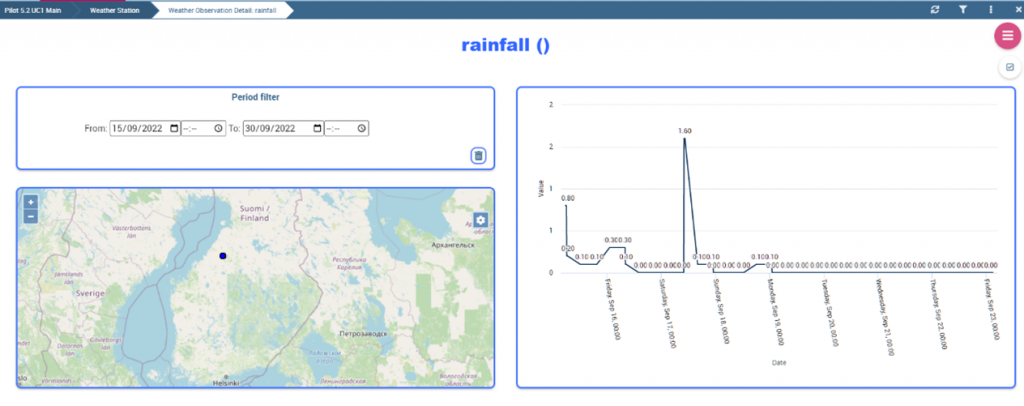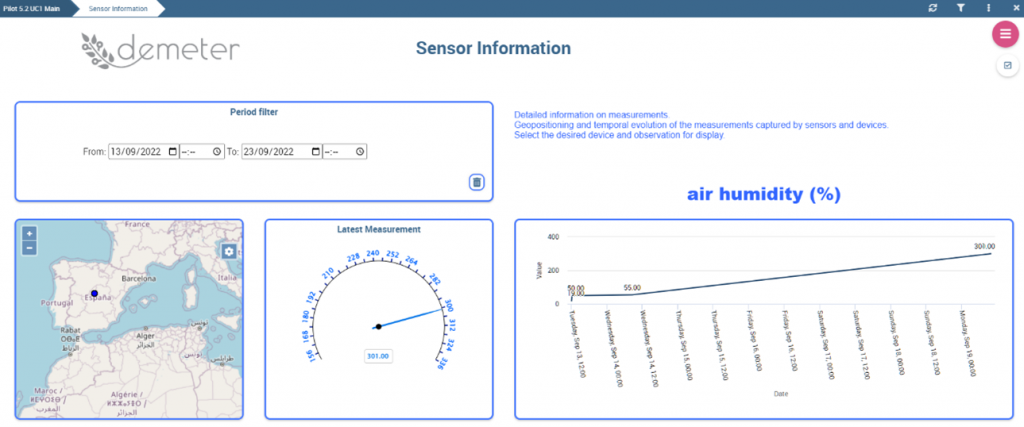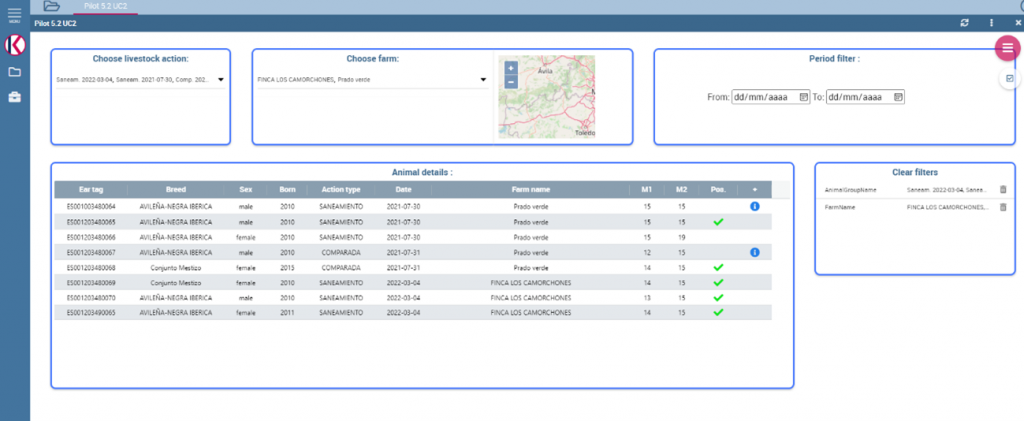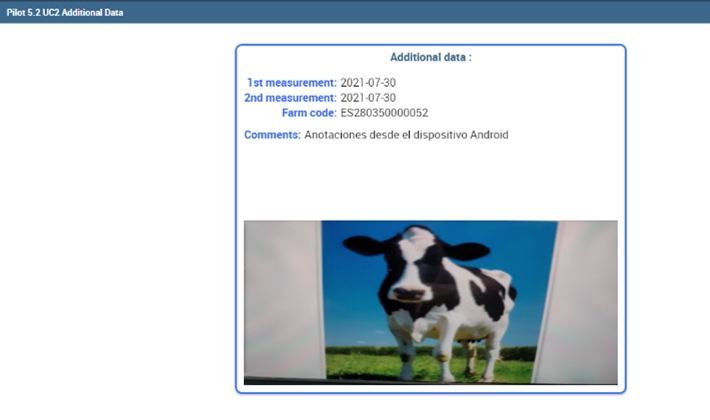
Overview
Our pilot ‘Farm of Things in Extensive Cattle Holdings‘ focuses on improving animals’ well-being and health by managing their optimal feeding, and how this can affect the quality of processed products such as dairy products and pastries, as well as cereals and eggs as raw materials. This pilot also considers end-user involvement in quality testing and feedback provision.
Three use cases are being developed in this project:
- UC#1: Ensuring the wellness of cows by managing their optimal feeding. Predicting the precise harvest time is a key variable to ensure optimal nutritional levels of the pasture. As harvesting for silage is a complex task involving many workers, this use case also focuses on improving farm work organization.
- UC#2: Improve the production management in a livestock farm integrating new technologies into the daily operations.
- UC#3: The food transparency and user involvement use case intends to integrate data brokering solutions in current production systems of dairy products and pastries.
The Farmers’ Collaboration Tool
The Farmers’ Collaboration Tool (FCT) is being developed in UC#1 and deployed in a Finnish farm (Kotipelto Farm) and its neighboring ones. As previously mentioned, the level of nutrients in the animals feeding depends among others on the time when harvesting is carried out. Farmers need to know the environmental conditions of crops (soil moisture and temperature, plant height, air temperature and humidity, etc.), D-value of the forage (digestibility of the forage), as well as the weather forecast to schedule the different harvesting tasks for silage to have an optimal nutritional level, involving several workers and machinery. Furthermore, in most cases, neighboring farmers share resources and machinery when harvesting, and need to talk to each other to book them for the most suitable day, a tedious and time-consuming activity that impacts the scheduling of farm tasks.
The FCT can be used by several farmers and assists them in scheduling the harvesting tasks, booking shared resources and machinery in a very easy and simple way, and thus saving time. On the one hand, the FCT provides farmers with the weather forecast, the environmental conditions of their fields, and other information, like the D-value or overlaying images of an area displaying the infrared spectrum, the RGB picture, etc., accessing and storing different data sources: sensors deployed on the field, sensors on board of ground robots, the national weather forecasting service, images captured by drones, etc. All this information will allow farmers to decide when to harvest. On the other hand, the FCT provides a user-friendly interface for farmers to book resources and close the planning of activities on the farm.
Currently, farmers need to use different solutions from different providers that implement, as a whole, most of the functionalities that FCT offers. Therefore, FCT facilitates the adoption of ICT solutions in agriculture.
The FCT can capture data straightforwardly from the sensors, images, etc., but can also access DEMETER Enhanced Entities (DEE) that bring data from other data sources, like the one developed in UC#1 that collects data from the AFarCloud Middleware. Additionally, the FCT will also be able to store data in the reverse direction, that is, the data in the FCT repositories could be transferred to any other DEE, using the DEMETER Agriculture Information Model (AIM) as an information interchange mechanism.
In the summer of 2022, the beta version of FCT was tested and shown to farmers in the Kotipelto Farm area. Farmers’ feedback has been overwhelmingly positive, and are eager to begin using a stable version as they see a way to save time and better organise harvesting activities.
Their suggestions have raised new needs and requirements that will be addressed in the next version of the FCT. The next harvest will take place from May to June 2023, and farmers will be using the stable version of the FCT by that time; good outcomes and results are expected from the FCT in late summer 2023.
Dashboard
UC#1 and UC#2 have used the DEMETER Adaptive Visualization Framework (AVF), based on Knowage, to show data to end users which incorporates any agricultural stakeholder such as farmers, agricultural engineers, agritech providers, etc. This information will allow them to make better decisions about the well-being of the livestock.
The dashboard of UC#1 shows data stored in the AFarCloud Middleware provided by several sensors, either on the field or onboard in a robot, and weather stations, operated mainly by the national weather forecast service. As previously stated when describing FCT, the data will assist farmers in planning harvest activities; also, the dashboard allows them to visualize data in the AFarCloud Middleware from other sites, not only from the Kotipelto farm and neighbouring farms. Briefly, the dashboard requests the AFarCloud, and the response comforming to the AFarCloud information model is processed to get a JSON-LD response based on the AIM that AVF can process and display on a screen.
The following figures show information from a weather station close to the Kotipelto farm and a sensor in Spain.

Figure 1. Dashboard showing the rainfall measured by a weather station close to Kotipelto farm

Figure 2: Dashboard showing the air humidity measured by a sensor in Spain.
In Figure 1, the user can select the period of time, and in previous steps, the weather station and the type of measurement (rainfall in this case). In Figure 2 the latest stored value is also displayed using a gauge.
The UC#2 dashboard displays in a user-friendly way the information about the livestock of a farm. The data has been uploaded by farmers, and more significantly, by the veterinarians. The veterinarian can use voice recognition to register animal parameters or comments and significant assessments, improving their experience and activities when inspecting the livestock of a farm. The dashboard makes a request to the site that stores the data, the response is converted into the JSON-LD messages that the AVF can process, and the results are displayed as depicted in the following figures.

Figure 3. Information about the cows in a farm.

Figure 4: Detailed information of a cow
Figure 3 shows an overview of the cows’ data on a specific farm. The user can select the farm and can also filter out information over some time. In addition, the farmer can click on a row with the data of a cow and can get more detailed information about it, as Figure 4 shows.
Next Steps
Concerning UC#1 We intend to get ready a stable version of the FCT to be released, tested, and debugged, so that we can use it in the next harvesting period and assess the benefits for the farmer, compared to the time when FCT and DEMETER were not available.
Furthermore, an ISOBUS device will be completed, and it will allow uploading to FCT significant data from the farm tractors, information that will allow the farmer to know the fuel consumption, the distance covered by each tractor, etc.
The FCT is now receiving data from the AFarCloud through the DEMETER Agricultural Interoperability Space (AIS), and we intend to get the same in the reverse direction.
We will also prepare the DEMETER Benchmarking Enabler for the use case, a valuable tool to compare the performance of Kotipelto with other farms.
With UC#2, workshops will be held in early 2023 with current workers to test the capacity of the tool and its integration in the DEMETER ecosystem to improve efficiency in food processes.
In relation to UC#3, we intend to integrate Data Brokering solutions in the current production systems of dairy products and pastries.
In our future work, we are close to having a notification system ready to facilitate the provision of information in the food production processes. This system will allow supply chain operators to include real-time information on incidents in the food manufacturing process, as well as to validate that the resulting product falls within the quality tolerances specified for that product.
Workshops with current workers will be held in early 2023 to test the ability of the tool and its integration into the DEMETER ecosystem to improve efficiency in food processes.
____________________________________________________________________________
This article was written by the partners participating in the pilot, namely UPM, Probot, Tragsa, Centria, Tecnalia, Codan.


